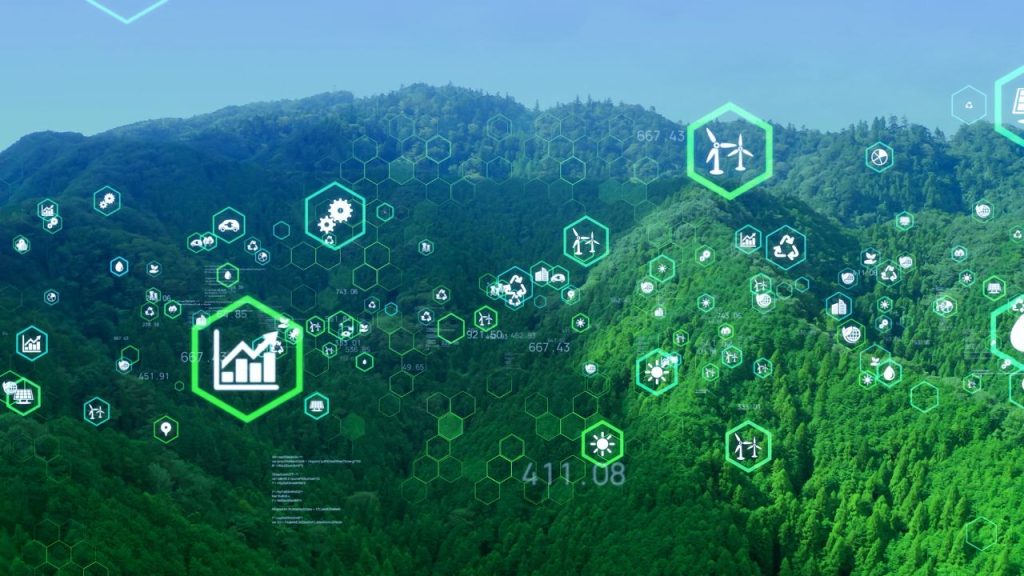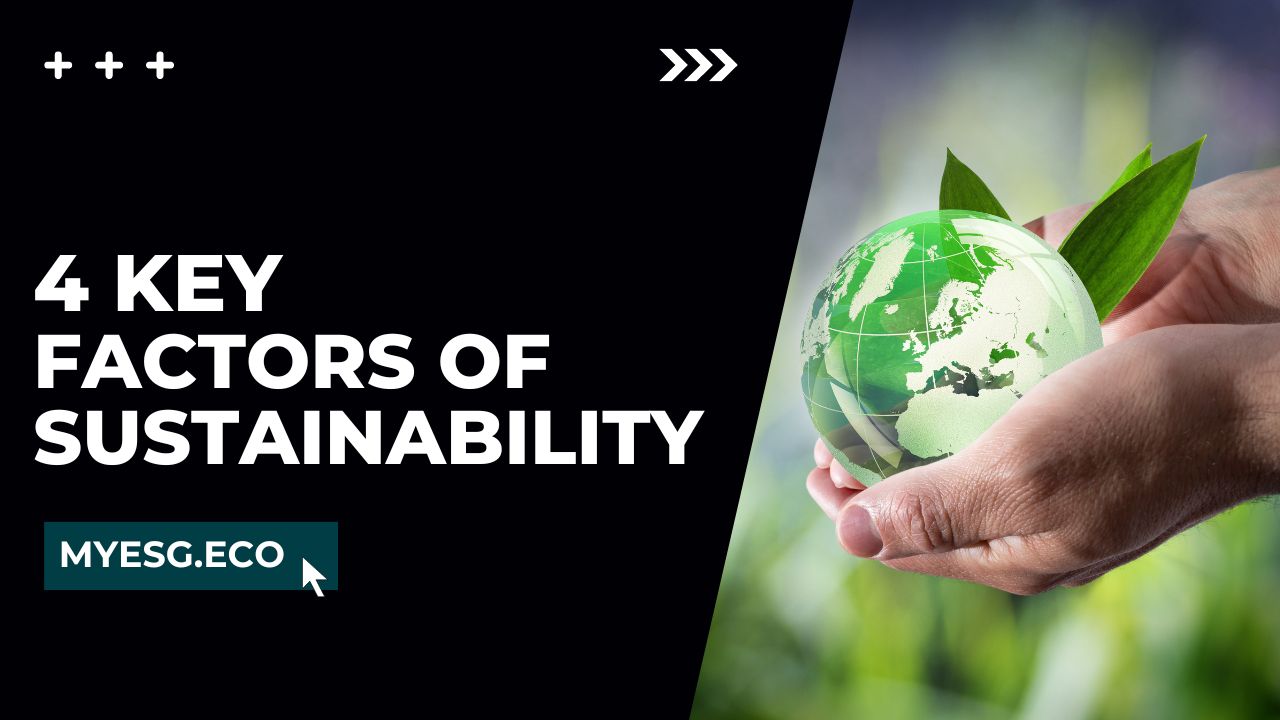Sustainability is becoming a major factor in business operations around the world.
As organizations strive to become more socially and environmentally responsible, they are looking for ways to reduce their impact on the planet while still maintaining profitability.
This article will explore four key factors of sustainability that can help businesses achieve sustainability goals, including reducing energy consumption, investing in renewable energy sources, and utilizing sustainable materials.
Table of Contents
1. Environmental Sustainability

Environmental sustainability refers to the responsible use and management of natural resources to protect and preserve the environment for present and future generations.
This is an essential aspect of sustainability, as environmental degradation can have a significant impact on the well-being of human and non-human life.
Conservation and protection of natural resources are crucial for ensuring the long-term availability and sustainability of these resources.
This includes protecting forests, oceans, and other natural habitats, as well as safeguarding freshwater resources and reducing water pollution.
Conservation and protection efforts can involve a variety of activities, such as reforestation, sustainable fishing, and responsible water use.
Reducing waste and emissions is a critical factor in environmental sustainability. This involves minimizing the amount of waste generated, maximizing recycling and composting, and reducing greenhouse gas emissions.
Efforts to reduce waste and emissions can include using renewable energy sources, improving energy efficiency, and implementing sustainable transportation systems.
Sustainable agriculture and food production involve using methods that minimize the environmental impact of food production while ensuring food security and providing economic benefits for local communities.
Sustainable agriculture practices can include organic farming, agroforestry, and crop rotation, among others.
The use of renewable energy sources such as wind, solar, and hydropower is critical for reducing greenhouse gas emissions and ensuring a sustainable energy future.
Investing in renewable energy technologies can provide significant economic benefits while reducing the reliance on fossil fuels.
Biodiversity preservation involves protecting and conserving the variety of living organisms that make up ecosystems.
Biodiversity is essential for maintaining the health of the planet and is threatened by activities such as deforestation, habitat destruction, and pollution.
Efforts to preserve biodiversity can include habitat restoration, protected area designation, and conservation of endangered species.
2. Economic Sustainability
Economic sustainability refers to the ability of an economy to maintain long-term growth while ensuring equitable distribution of resources and opportunities.
Economic sustainability is important because it allows for continued economic development while preserving the planet’s resources and ensuring social well-being.
Sustainable business practices involve operating a business in a way that minimizes negative impacts on the environment and society while providing economic benefits.
This can include using eco-friendly materials, reducing waste and energy use, and engaging in socially responsible practices, such as fair labor practices.
Investment in sustainable infrastructure involves developing infrastructure that promotes economic growth while reducing environmental impacts.
This can include investments in renewable energy, sustainable transportation systems, and sustainable buildings.
Resource efficiency involves the efficient use of resources to minimize waste and reduce environmental impact while maintaining economic benefits. This can include reducing energy use, water conservation, and using recycled materials.
Ethical and responsible investing refers to investing in companies that adhere to environmental, social, and governance (ESG) principles, which aim to promote sustainable practices, social well-being, and ethical conduct.
This can include investing in companies that have low carbon emissions, promoting diversity and inclusion, and engaging in ethical labor practices.
Sustainable supply chain management involves ensuring that products and materials are produced and transported in a way that minimizes environmental impact while promoting social and economic benefits.
This can include using eco-friendly materials, reducing waste and emissions during production, and ensuring fair labor practices throughout the supply chain.
3. Social Sustainability
Social sustainability is a critical aspect of sustainable development that focuses on the well-being and quality of life of individuals and communities.
It encompasses various dimensions that are crucial to promoting equitable and just societies, including access to education and healthcare, diversity, equity, and inclusion, community development and engagement, responsible consumption and production, and fair labor practices.
Access to education and healthcare is essential to ensuring that everyone could live a healthy and fulfilling life.
Education provides individuals with the knowledge and skills needed to improve their livelihoods, while healthcare enables them to maintain good health and well-being.
Ensuring universal access to quality education and healthcare is therefore critical to promoting social sustainability.
Diversity, equity, and inclusion are key components of social sustainability. Diversity refers to the range of human differences, while equity refers to the fair distribution of resources and opportunities.
Inclusion involves creating a sense of belonging for all individuals, regardless of their differences.
By promoting diversity, equity, and inclusion, societies can foster a sense of unity and reduce discrimination and marginalization.
Community development and engagement involve working with local communities to promote sustainable development. This can include initiatives to improve infrastructure, create jobs, and enhance access to essential services.
It also involves engaging with communities to understand their needs and aspirations and involving them in decision-making processes.
Responsible consumption and production are critical to promoting sustainable development. This involves reducing the use of non-renewable resources, minimizing waste, and promoting the use of environmentally friendly products and practices.
By promoting responsible consumption and production, societies can minimize their impact on the environment and create more sustainable systems.
Fair labor practices involve ensuring that workers are treated fairly and equitably. This can include providing fair wages, safe working conditions, and opportunities for professional development.
By promoting fair labor practices, societies can create more equitable systems that promote social sustainability.
4. Technological Sustainability
Technological sustainability is a critical aspect of sustainable development that focuses on developing and using technologies that support human well-being and environmental sustainability.
It encompasses several dimensions crucial to promoting sustainable development, including innovation, sustainable design and engineering, green technology and clean energy, data privacy and security, and responsible technology use.
Innovation for sustainable development involves promoting research and development of new technologies that contribute to sustainable development.
This includes technologies that reduce negative environmental impacts, enhance the well-being of individuals and communities, and promote sustainable economic growth.
It also encourages collaboration between the private sector, government, and civil society to support innovation that contributes to sustainable development.
Sustainable design and engineering involve developing products, systems, and infrastructure that promote sustainable development.
This includes designing buildings and transportation systems that minimize negative environmental impacts and developing sustainable products that are energy-efficient, non-toxic, and recyclable.
It also involves promoting sustainable materials and ensuring that products and systems are designed with the end-of-life in mind.
Green technology and clean energy promote the development and use of technologies that reduce negative environmental impacts and promote sustainable development.
This includes using renewable energy sources such as solar, wind, and hydropower and developing energy-efficient technologies for buildings, transportation, and industrial processes.
It also involves promoting technologies that reduce waste and pollution and promote the sustainable use of natural resources.
Data privacy and security are critical to promoting sustainable development, as technology often involves collecting and processing personal data.
This involves promoting policies and regulations that protect individuals’ privacy and ensuring that personal data is used ethically and responsibly.
It also consists in developing secure technologies and ensuring that data is protected from cyber threats and unauthorized access.
Responsible technology use involves promoting the responsible use of technology by individuals and organizations. This includes fostering digital literacy and ensuring that individuals can access the tools and resources to use technology responsibly.
It also involves promoting ethical and responsible use of technology, including social media, online communities, and other digital platforms.
Finally, it consists in promoting responsible decision-making around technology use, including considering the potential impact on individuals, communities, and the environment.
Conclusion
Sustainable development is not just about preserving the environment and economic growth but also about the well-being and quality of life of individuals and communities.
It’s about ensuring that everyone has the opportunity to thrive and that future generations have the resources they need to survive and flourish.
Sustainable development is a human-centered goal that requires a holistic approach that addresses the complex challenges facing our world.
It involves promoting economic, environmental, social, human, and technological sustainability to create a more equitable and just world for all.
Achieving sustainable development requires a shared vision, commitment, and action toward sustainable development goals.
By working together, we can create a world that promotes the well-being and quality of life of all individuals, protects the planet we call home, and ensures a sustainable future for generations to come.

